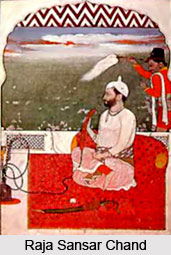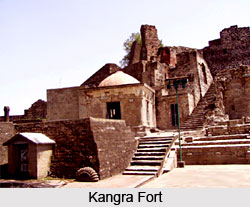 History of Hamirpur District is closely associated with Katoch dynasty which ruled the area between Ravi River and Sutlej River in the past. It is evident from the "Indian Puranas" and Panini`s "Ashtadhyai" that during the Mahabharata era, Hamirpur was a part of the old Jallandhar-Trigarta Empire. Panini referred to the people of this kingdom as great warriors and fighters. As per the history of Hamirpur District, it is believed that in the ancient period, the rulers of Gupta dynasty had set up their sovereignty over this part of the land.
History of Hamirpur District is closely associated with Katoch dynasty which ruled the area between Ravi River and Sutlej River in the past. It is evident from the "Indian Puranas" and Panini`s "Ashtadhyai" that during the Mahabharata era, Hamirpur was a part of the old Jallandhar-Trigarta Empire. Panini referred to the people of this kingdom as great warriors and fighters. As per the history of Hamirpur District, it is believed that in the ancient period, the rulers of Gupta dynasty had set up their sovereignty over this part of the land.
Further, history of Hamirpur Dynasty during the middle ages, presumably the area fell under the control of Mahmud of Ghazni, Timurlang and later Sultans. But with the passage of time, all these rulers went away and at the time of Hamir Chand, a Katoch ruler, the area was under the control of `Ranas` (Feudal hill chiefs). Some of the prominent Ranas were Ranas of Mewa, Ranas of Mehalta and Dhatwal. It was only the Katoch dynasty which put these Ranas under its control, to ensure an orderly society. The Katoch dynasty became predominant during the period of Hamir Chand who ruled from 1700 A.D. to 1740 A.D.
Hamir Chand built the fort at Hamirpur and the present town of Hamirpur derives its name from his name. Raja Sansar Chand ruled from 1775 A.D. to 1823 A.D. He dreamt of establishing the old empire of Jallandhar-Trigarta, which his ancestors had held at one time. The rise of Raja Ranjit Singh proved a great hurdle for his ambitions. Therefore, he diverted his attention towards the local hill chiefs. He attached Mandi state and made Raja Ishwari Sen a pioneer for 12 years at Nadaun. He also obliged the Suket ruler to pay an annual tribute and annexed parts of Bilaspur state on the right bank of Sutlej River. Becoming alarmed by the advancement of Sansar Chand, all the hills chiefs joined hands and invited the Gurkhas to stop the uncontrolled might of Katoch ruler. The combined armies fought against Sansar Chand`s army at Mahal Morion in Hamirpur. They were defeated by the army of Raja Sansar Chand and they were compelled them to retreat on the left banks of river Sutlej.
 By that time, Raja Sansar Chand, made some changes in his existing army. On hearing about the weakness of Katoch`s army, the combined forces again attacked the forces of Kangra at Mahal Morian in the second battle and forced a crushing defeat in 1806 A.D. Raja Sansar Chand along with family took shelter in the Kangra fort. The Gurkhas seized the Kangra fort and ruthlessly looted the area between the fort of Kangra and Mahal Mohrian and virtually destroyed the villages. Ishwari Sen was liberated by the Gurkhas from Nadaun jail. The siege of the fort continued for three years. Raja Ranjit Singh on the request of Sansar Chand, waged war against the Gurkhas and defeated them in 1809 A.D. But Sansar Chand had to pay a heavy price and he had to lose Kangra fort and 66 villages to the Sikhs. The Sikhs maintained their sovereignty over Kangra and Hamirpur till 1846 when they were defeated by the British army in the first Anglo-Sikh war. Ever since, the supremacy of the British continued in the area which became a part of the British Empire. After the death of Raja Sansar Chand, his successor Raja Pramodh Chand in alliance with the Sikhs and other rulers tried vainly to dislodge the British.
By that time, Raja Sansar Chand, made some changes in his existing army. On hearing about the weakness of Katoch`s army, the combined forces again attacked the forces of Kangra at Mahal Morian in the second battle and forced a crushing defeat in 1806 A.D. Raja Sansar Chand along with family took shelter in the Kangra fort. The Gurkhas seized the Kangra fort and ruthlessly looted the area between the fort of Kangra and Mahal Mohrian and virtually destroyed the villages. Ishwari Sen was liberated by the Gurkhas from Nadaun jail. The siege of the fort continued for three years. Raja Ranjit Singh on the request of Sansar Chand, waged war against the Gurkhas and defeated them in 1809 A.D. But Sansar Chand had to pay a heavy price and he had to lose Kangra fort and 66 villages to the Sikhs. The Sikhs maintained their sovereignty over Kangra and Hamirpur till 1846 when they were defeated by the British army in the first Anglo-Sikh war. Ever since, the supremacy of the British continued in the area which became a part of the British Empire. After the death of Raja Sansar Chand, his successor Raja Pramodh Chand in alliance with the Sikhs and other rulers tried vainly to dislodge the British.
Modern history of Hamirpur District states that British rulers made Kangra a separate district of which Hamirpur formed a part. Kullu and Lahaul-Sipiti were also merged to form the part of the district. In 1846, after annexation of Kangra, Nadaun was made the tehsil headquarters. This settlement was revised in 1868, and as a result the tehsil headquarters was changed from Nadaun to Hamirpur. In 1888, Palampur tehsil was created, merging part of the areas of Hamirpur and Kangra tehsils. Hamirpur remained a part of Punjab province until 1st of November 1966, when these areas were merged in Himachal Pradesh consequent upon the reorganization of Punjab.
As a result of re-arrangement of the districts in the merged areas on 1st of September 1972, Hamirpur was created as a separate district with two tehsils of Hamirpur and Barsar. In 1980 three more tehsils namely Tira Sujanpur, Nadaun, Bhoranj were created with the further reorganization of the tehsils.



















